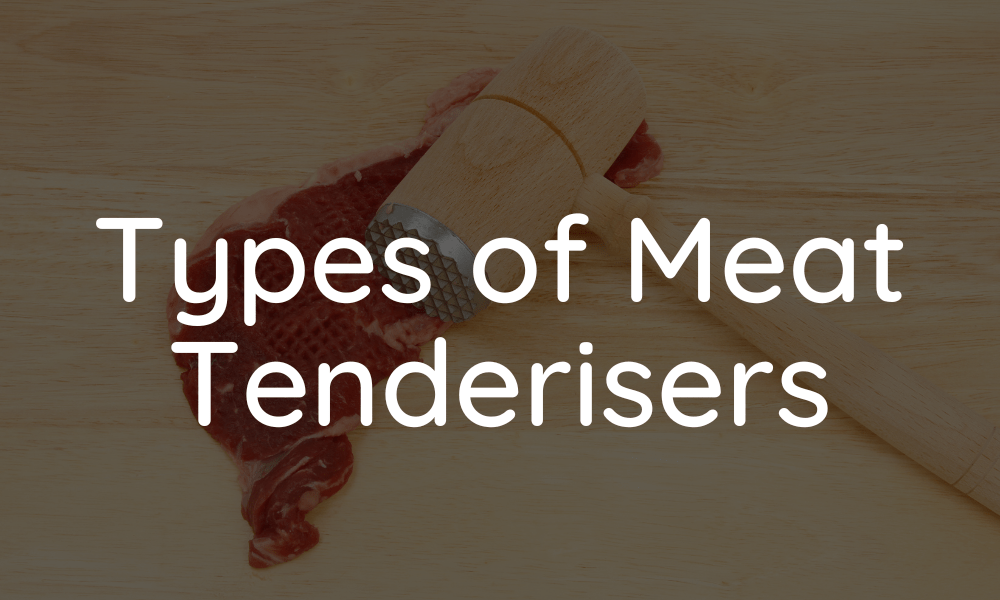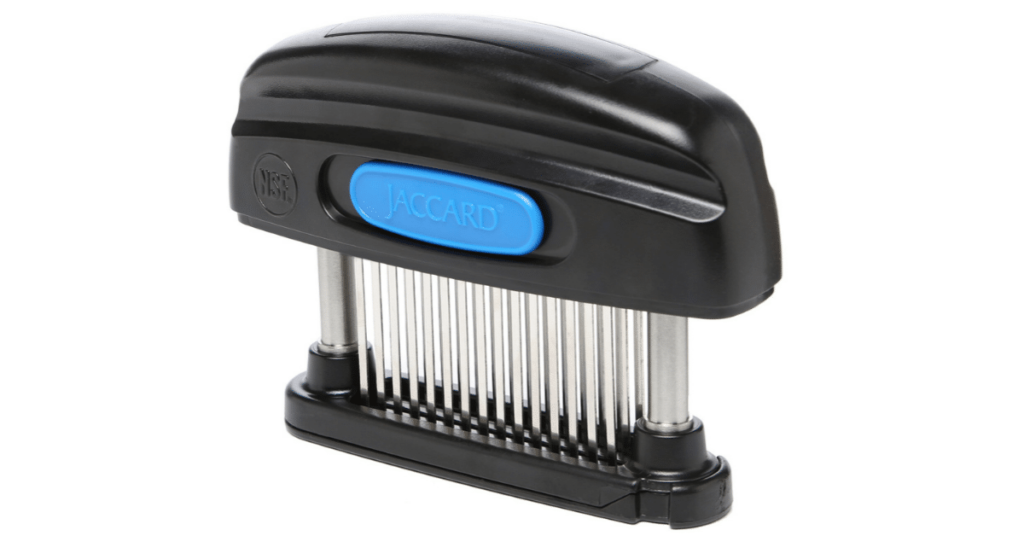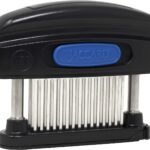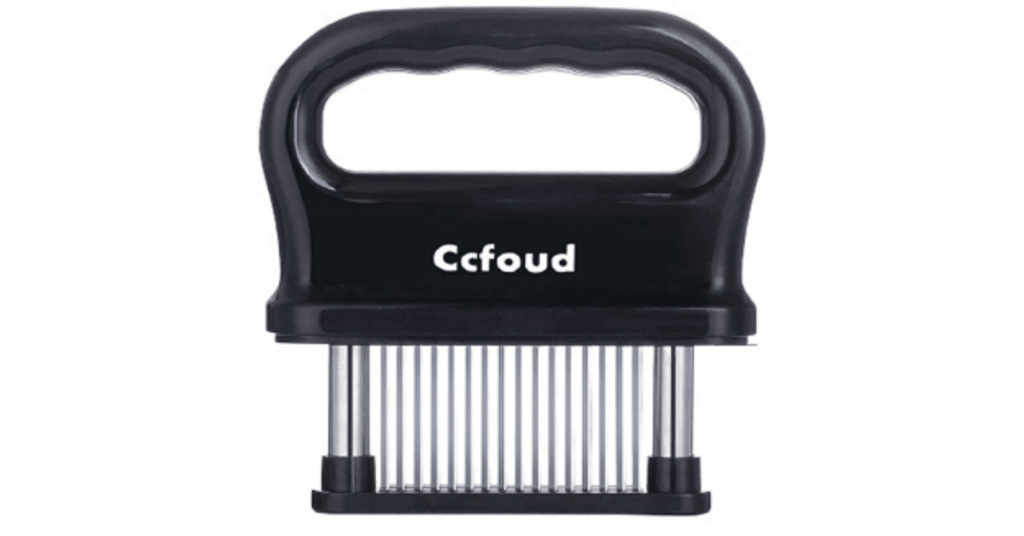Do you want to know the best meat tenderizers? If you’re frustrated with using a hammer, rolling pin, or cast-iron skillet every time you want to tenderize your meat, it’s time to invest in a meat tenderizer. You deserve some rest, so you should rest your arm and cutting board.
Here you can learn about the different types of meat tenderizers.
Most common tenderizers are hammer-shaped. Handing and operating them is convenient. Many are dual-sided, and the flat side helps in smoothing out and softening meat.

Hammer-shaped tenderizers are stainless steel and have a cushioned handle covered with decent material. You can also get wood handles if you prefer them! Some meat hammer enthusiasts may know the brands such as Oxo Good Grip or Non-Pro Gripez and Dalstrong.
- Masher Shaped Tenderizers
There is no comparison between hammer-shaped and masher-shaped tenderizers, and it is ten times more convenient to use a masher-shaped tenderizer than a hammer-shaped one. Because its rounded head has enough surface area to produce a very flat and even piece of protein, the long handle gives you a good grip when using it.
The blade sticks out, so you should be careful when using it.
Plastic or metal bodies are usually utilized in masher-shaped tenderizers but stainless steel blades. You now know about a few types of meat tenderizers, so let’s dig a little deeper. You are familiar with all of the following tenderizers, or you’ve used them. Therefore, you can pick the most suitable tenderizer for your needs.
- Commercial Meat Tenderizer
- Blade Tenderizer
- Meat Mallet
- Powdered Meat Tenderizer
- Natural Meat Tenderizer
As we move forward, we will dive into each of the best meat tenderizers.
1. Commercial Meat Tenderizer
Restaurants and large kitchens use commercial meat tenderizers to make fajitas or stir-fry. Cut flank steaks, sirloins, chickens, pork chops, pork breasts, or other portions of pigs with these machines.
Slices of cooked ham or cheese can be cut automatically, and they are beneficial for garnishes and salads. The meat can be cut with a sharp stainless steel blade.
A meat tenderizer can also be considered commercial when it is a meat cuber that is more commonly found in restaurants and grocery stores. They truly deserve the name “commercial.”
2. Blade Tenderizers
A blade meat tenderizer cuts muscle fibers with over a dozen needles and blades.

The perforations in your steak or beef help enhance the flavor, and you will also cook your meat faster.
You may not be able to get thin strips of steak or chicken with blade meat tenderizers since they tend to tear the meat apart. Specifically, they produce the best results on thicker meats and steaks, particularly the fillet mignon.
Since you’re dealing with dozens of spikes and needles, the clean-up process is a significant undertaking and can even prove dangerous. A meat mallet and a blade tenderizer result in the same results despite being at opposite ends of the spectrum. They are just different in the techniques they use.
3. Meat Mallet
It is shaped like a mallet/hammer, so it is ideal for ensuring an even layer of thickness throughout your desired choice of meat. As you hammer meat, the spikes on the mallet’s side would pierce the meat.
You can cook your chicken or meat faster with a meat mallet since it flattens chunky or more oversized meat pieces. Spikes puncture holes that allow the marinade to penetrate deeper. It pounds, flattens, and pierces meat simultaneously, making it 100% versatile.
4. Powdered Meat Tenderizer
Powdered meat tenderizers are among the best. Consequently, it is well known for its ability to facilitate the breakdown of protein chains. Pineapple stems contain the enzyme bromelain, which is found in pineapples also.

It only takes a short period for pineapple juice to marinate steaks, chicken, beef, or pork. Oversoaking your meat will cause it to fall apart! Pineapple is not a good food to turn into jam or jelly is now clearly apparent in centuries; folk medicine has used bromelain as a topical medicine. Besides topical medicine, it has also been used cosmetically to tenderize meat. Do you see what I mean? One stone, two birds.
Bromelain is a group of enzymes extracted from a handful of plants. The enzymes in pineapple juice can eat away the skin of pineapple processors, so they must wear masks and gloves. Bromelain is not found in canned pineapple; you must use a fresh one to extract all the benefits of the marinade.
The powdered meat tenderizer papain is yet another option. It is easy to find Bromelain and Papain on Chef Master’s website, and they are two of the best-unseasoned meat tenderizers on the market.
In my experience, it works best on tough meats such as goats and sheep. The enzymes Bromelain and Papain are efficient at breaking down collagen as fast as possible.
5. Natural Meat Tenderizer
Plenty of natural meat tenderizers is available, such as fruits, papayas, and pineapples. Here are a few more:
- Baking soda
Baking soda is a fantastic product that contains numerous health benefits. As well as cleaning deep and dirty corners in your house, it acts as a natural meat tenderizer. This product can also be used to remove plaque from your teeth.

To use your protein, sprinkle some baking soda on it. Rub it well, and let it settle for several hours. It is also possible to turn the soda into a paste by DIY work. Baking soda and water are combined, and the meat is coated and is left to marinate. Rinse the meat well before cooking!
- Soy Sauce
A tough meat protein called Myosin is known to be broken down by soy sauce. A thicker cut would be most efficient with this technique. They add flavor to your dish and let your meat soak longer than 4 hours.
- Tea
Tea tannins act as natural tenderizers. Just make two strong cups of black tea, allow it to cool for no more than twenty-five minutes, and gently dip your protein of choice into it. Leaving it in the tea bath for 24 hours will make it more tender, and the longer you leave it in the tea bath, the softer it will be.
- Coffee
Coffee enhances the flavor of food as well as tenderizes meat naturally. The next step is to make a strong coffee and allow it to cool down before you soak your meat in it for up to 24 hours.
- Fruits
The enzyme papain is found in pineapples, papayas, kiwis, and figs. Commercially, they are used to tenderize meats. You can use thin slices of these fruits instead of bromelain or Papain and rub them on meat if you don’t want to use your hands for safety.
Uses of Meat Tenderizers
The purpose of a meat tenderizer is to smooth out tricky parts of meat. Hard or chewy meat is transformed into the soft and tender meat. After the meat has been pounded out, meat tenderizers can also smooth out any uneven surfaces.
Tenderizing most meat cuts can be accomplished with this tool. Pounding different-sized meat to a similar thickness and size using a meat tenderizer helps unify cooking time. Additionally, it prevents gristle formation.
Pros and Cons Of Meat Tenderizer
Below are some reasons you might or might not need a tool for pounding, flattening, and slashing raw meat cuts.
Pros
- Foods that are thinner and softer are easier to chew
- Cook evenly by ensuring the same thickness
- Cooking time can be reduced
- Save money by well-treating cheaper steaks, which may be more challenging than more expensive cuts
- Allow meat to absorb flavors quickly and effectively from marinades and seasonings
Cons
- Using a heavy mallet or pounder during the process can change the meat’s structure and moisture
- Some products can tear skinny cuts
Frequently Asked Questions(FAQs)
- What is a meat tenderizer?
Meat tenderizers or meat pounders are hand-powered tools used to break down tough cuts and sections of meat. You can make a meat tenderizer or pounder from any sharp object with a large surface area. However, meat tenderizers and meat pounders are made to serve their sole purpose.
- What is a good meat tenderizer?
A meat tenderizer comes in two parts so you can get the best results. Your choice of protein would be flattened on the first side. With the second side, you would be able to puncture through tough muscle fibers and puncture through the meat.
- Does meat tenderizer work?
The answer to this question requires some quick experimentation. Select your preferred meat and experiment with both methods. You can use the tenderizer on one meat and not on another. It is believed that meat that has been tenderized will have a more robust flavor and be easier to digest.
Final Verdict
In this post, we’ll discuss types of meat tenderisers. The Meat Tenderizer’s large surface area and ergonomic top-handle design make it a top choice for everyday cooking.







